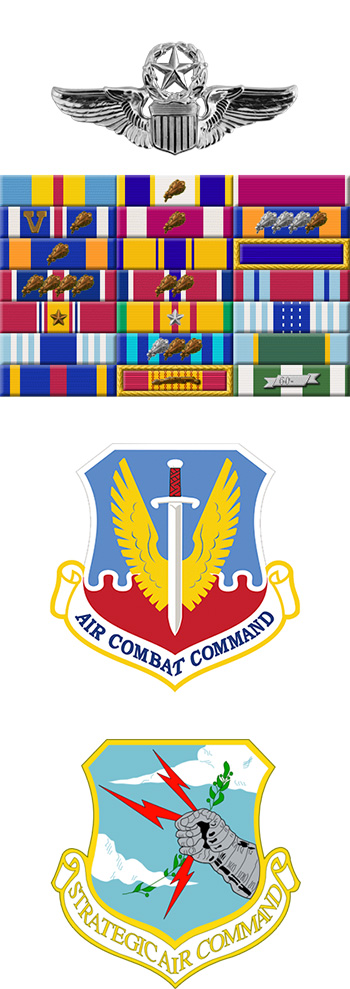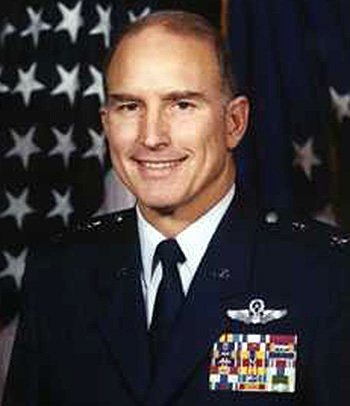
|
Brett M. Dula |
 |
|||
| Rank, Service | ||||
Lieutenant General O-9, U.S. Air Force |
||||
| Veteran of: | ||||
|
||||
| Tribute: | ||||
Brett Dula was born on June 30, 1942, in Upland, California. He entered the U.S. Air Force Academy in June 1960, and was commissioned a 2d Lt in the Air Force on June 3, 1964. Lt Dula next completed Undergraduate Pilot Training and was awarded his pilot wings at Craig AFB, Alabama, in September 1965, followed by B-52 Stratofortress Combat Crew Training from September 1965 to February 1966. His first assignment was as a B-52 pilot with the 28th Bomb Squadron at Homestead AFB, Florida, from October 1965 to September 1967, and he then attended O-2 Milirole Forward Air Controller (FAC) school before serving as an O-2 FAC with the 23rd Tactical Air Support Squadron at Nakhon Phanom Royal Thai AFB, Thailand, from December 1967 to July 1968. He served as an O-2 FAC with the 20th Tactical Air Support Squadron at DaNang AB, South Vientam, from July to December 1968, and then completed B-52 refresher training from January to April 1969. Capt Dula next served as a B-52 pilot with the 62nd Bomb Squadron at Barksdale AFB, Louisiana, from May 1969 to April 1971, followed by service as aide-de-camp to the Commander of 2nd Air Force, Gen Russell E. Dougherty, at Barksdale AFB from April 1971 to May 1972, and then continuing as his aide-de-camp when he became Chief of Staff at Supreme Headquarters Allied Powers Europe in Mons, Belgium, from May 1972 to May 1974. Maj Dula served as an F-111 Aardvark pilot, as Assistant Operations Officer for the 522nd Tactical Fighter Squadron, and then as Executive Officer with the 27th Tactical Fighter Wing at Cannon AFB, New Mexico, from October 1974 to August 1977. He attended Armed Forces Staff College at Norfolk, Virginia, from August 1977 to February 1978, and then served as Chief of the Bomber Branch, Chief of the Air Vehicle Division, and then as Chief of the Advanced Development Division with Headquarters Strategic Air Command at Offutt AFB, Nebraska, from March 1978 to December 1980. His next assignment was as Commander of the 4007th Combat Crew Training Squadron at Plattsburgh AFB, New York, from December 1980 to June 1982, followed by service as Deputy Director of Aerospace Requirements with Headquarters Strategic Air Command from June 1982 to June 1983. Col Dula served as the Executive Officer to the Commander in Chief of Strategic Air Command, Gen Bennie L. Davis, from July 1983 to July 1984, and then attended National War College at Fort McNair, Washington, D.C., from August 1984 to June 1985. His next assignment was as Commander of the 416th Bomb Wing at Griffiss AFB, New York, from July 1985 to January 1987, followed by service as Commander of the 2nd Bomb Wing at Barksdale AFB from January 1987 to January 1988. Gen Dula served as Inspector General of Strategic Air Command at Offutt AFB from January 1988 to January 1989, and then as Deputy Director and Director of Legislative Liaison and Director of Air Force Issues with Headquarters U.S. Air Force in the Pentagon from February 1989 to May 1991. His next assignment was as Vice Commander of 8th Air Force at Barksdale AFB from June 1991 to July 1992, followed by service as Commander of 2nd Air Force at Beale AFB, California, from July 1992 to July 1993. Gen Dula served as Deputy Director of the Central Imagery Office in Vienna, Virginia, from July 1993 to June 1995, and then as Deputy Inspector General for the U.S. Air Force at the Pentagon from June to December 1995. His final assignment was as Vice Commander of Air Combat Command at Langley AFB, Virginia, from December 1995 until his retirement from the Air Force on August 1, 1998. |
||||
|
||||

